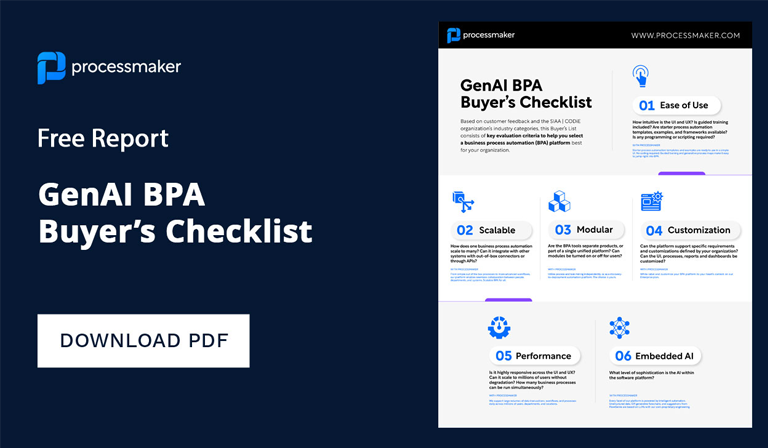One of the main benefits of automated workflow is time savings. How does a workflow save time? It utilizes a series of sequential processes or steps, that can be executed without any manual intervention – so then, there is a flow. With automation, this entails adding digitization to the mix which will improve speed and accuracy.
When the time used to complete a task is reduced, employees then have more time to focus on higher-level work. With an automated workflow, each task is immediately triggered once the previous task is completed. Therefore, the right steps are taken in the right order and the workforce is free to concentrate on their core job responsibilities.
Digging deeper into the workflow
In the simplest of terms, a workflow is a management, and associated processes, of a repeatable business task. In fact, focus on the word repeatable because a workflow is used to execute tasks that require deployment on a continuous basis.
To give you a better idea of how this works, let’s cover a practical example: employee onboarding. Whenever you hire a new employee, you need to explain how the company works, what their role is, and so on.
For instance, if you were recruiting a new employee, you probably already have a series of tasks in place to get them started such as a resume request, setting up a phone call interview, setting up an in-person interview, evaluating their skills and experience relative to other prospective hires, running a background check, generating tax and employment documents for e-signature, negotiating their salary and benefits’ package and so on.
In realistic terms, when people think of workflow they often think of workflow management software. You could write down a sequence of tasks, but it will simply sit idle on your sheet of paper. Although, visualizing how you want your workflow to start and end is the first step. You can do so by flowcharting workflows, which can also help you to identify and address potential bottlenecks. With a workflow diagram, you can also organize your tasks much more efficiently.
Think of the repeatable tasks that need to be executed, how many steps it would take, and who would be responsible for ensuring they are deployed. Before designing your process in a BPMN modeler, start with a workflow diagram to make sure you’ve covered everything.
The components which make up your workflow
Every workflow has a set of components that comprise the whole. Here they are in no particular order:
- Activities: Which tasks will be executed throughout the workflow?
- Actor/s: Who holds the responsibility for carrying out the tasks?
- Results: What does the end result look like?
Create the workflow
As with anything else, there are a few core steps to ensure the relevancy of your workflow diagram. Continue reading to learn more.
Step 1: What job would you like to set up as a workflow? Is it repeatable? Get help from the actor/s who usually carry them out.
Step 2: Collaborate with the actor/s regarding which tasks need to be included and which processes can be eliminated with a nod to efficiency. Then, discuss your desired expectations in terms of results.
Step 3: Map out every process in acute detail. When you do this, you will start to clearly visualize the tasks which are wasteful and can either eliminate them or outsource the task to improve efficiency.
Step 4: Make a rough estimate of how much time each task would take. At this point, you don’t have any experience. Once you get your workflow going, you can update this section of your diagram.
Step 5: Put all your pieces together to create your workflow diagram. Make sure to include the key components – the actor/s, activities, and anticipated results.
Remember, your workflow diagram isn’t static. This should be an evolving document. Continue to refine the processes as you move forward, learn more, and modify your objectives. Once you’re ready, you can design your process in a BPMN 2.0 software where your workflows can be executed.
Keep the technology simple, to start
When you are ready to digitize your workflows, it’s critical to start with an organizational self-evaluation. There might be plenty of excitement around what you can do with your new software – but, you need to keep your expectations realistic. In addition, you want a software solution that aligns with your expectations and budget. If you have not used workflow software in the past, it can be overwhelming at first. Take things slowly, and start small. Begin with a simple process and take it from there. Learn how things work before doing an end-to-end deployment. Give your actor/s time to get used to the software, as well.
Considering the manual processes
This is an important section because workflows are all about managing manual processes more efficiently. Where is the low-hanging fruit? Which manual processes take your employees the most time to complete? Which manual processes prevent your employees from focusing on their higher-level tasks? These are the processes you should start with when implementing workflow software.
Now, instead of data entry, you can use task triggers. In contrast to manual hand-offs, you can use workload balancing and/or automated work distribution. You’ll start to notice the ROI immediately as you automate some of your most time-draining manual tasks.
What’s next?
Give your company, and affected parties, some time to understand the general components of what makes up a workflow and ultimately, how it works. When you start small, you can then see an increasing set of possibilities start to reveal themselves. Then, keep it simple. As a result, your processes will be easier for everyone to follow and maintain.





